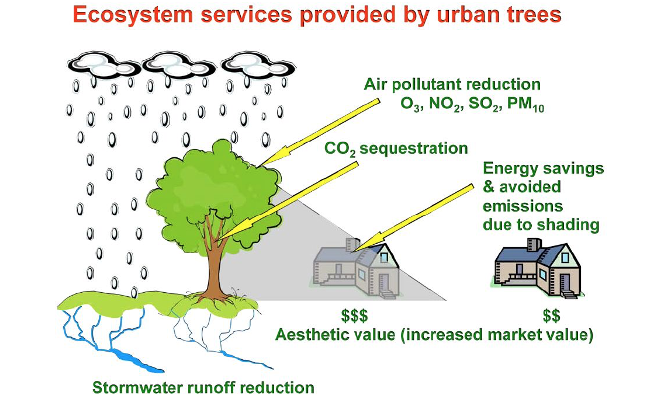CommentsPLANNING WATCH - In last week’s Planning Watch column, I pointed out that LA’s underwhelming urban forest is a key indicator that the city’s planning glass is mostly empty.
There is also another way to reach this same conclusion; you can see poorly planted or totally barren parkways everywhere in Los Angeles. Where I live, in a century old Los Angeles neighborhood near the Miracle Mile, there are still many streets like the ones in the photo above, that do not yet have any parkway trees.
Is this because LA was mostly treeless before mass urbanization, with only a few species of protected indigenous trees: Western Sycamore, Southern California Black Walnut, several oak species, and California Bay? Or, alternatively, is it because most trees require extra care to survive in LA’s unstable Mediterranean climate?
While plausible explanations, they are both wrong. One thing that observant Angelinos note when they go to nearby cities, such as Beverly Hills, Santa Monica, Calabasas, and Burbank, is that they have well maintained trees on every street. In these cities the urban forest is a high priority governmental responsibility, with properly funded municipal departments responsible for planting and nurturing their trees.
Unfortunately, Los Angeles is the exception, as confirmed in a recent report prepared for City Hall by Dudek environmental consultants: First Step: Developing an Urban Forest Management Plan for the City of Los Angeles. The Dudek study confirmed what Angelinos observe every day:
- Trees are not valued in the City of LA’s budget and planning processes.
- LA’s Urban Forest budgets are far below necessary levels.
- Dedicated staff lack direction from the City’s elected officials.
- City Hall’s ongoing approaches are scattered and have little follow through.
- The City does not know enough about its trees.
- The City’s technological urban forest management tools are incomplete.
- The City’s urban forest has significant gaps to achieve sustainability.
- The City lacks comprehensive urban forest planning and management guides.
- The City’s short-term responses prevent more comprehensive planning for its urban forest.
How can Los Angeles respond to the Dudek report by systematically planning and caring for its urban forest?
The answer is to prepare an Urban Forest General Plan Element, as elaborated in an outstanding position paper from the Coalition to Preserve LA. This officially adopted General Plan element must include an Urban Forest Management Plan. This new element, including its urban forest management plan, should include the following:
- Tree selection should emphasize native species because they have evolved to tolerate historical variations in local temperature and rainfall, including heat waves and droughts.
- Tree planting must be followed by watering until trees are fully established, plus trees must be pruned in perpetuity.
- Tree planting and maintenance must be properly funded. Comparable cities devote 1 percent of their municipal budget to the urban forest, while Los Angeles only allocates ¼ of 1 percent.
- The implementation of an Urban Forest General Plan Element must assure equitable outcomes for all neighborhoods since LA’s tree canopy coverage is as low as 1 percent in some neighborhoods, while others have 25 percent coverage or even more. The professional target of 40 percent tree canopy coverage should apply to all neighborhoods, regardless of their current status.
- City departments that deal with urban forest issues, whether in public areas or on private parcels, including the Bureaus of Engineering and Street Service, and the Departments of Water and Power, Building and Safety, Transportation, and City Planning, must synchronize their operations through the City Forest Officer.
- To assure the proper implementation of this new General Plan element, its policies and programs must be carefully monitored. Its implementation programs must be revamped when they do not meet such goals as equitably increasing LA’s tree canopy coverage.
This holistic approach makes sense for many reasons, both old and new.

The old reasons include the mitigation of urban heat islands and the removal of toxic air pollutants. These benefits would prevent up to 9,000 premature deaths per year. Other advantages include increasing home values, boosting local commercial districts, increasing biodiversity, and absorption or rainwater into aquifers.
The new reasons include the mitigation of heat waves resulting from climate change, by sequestering atmospheric carbon. Parkway and front yard trees can also make cities more walkable and, therefore, less reliant on cars. In addition, an enhanced urban forest can reverse LA’s dramatic loss of tree cover over the past two decades, largely caused by private real estate development.
The Coalition to Preserve LA’s position paper summed up the importance of these changes to LA’s urban forest as follows:
“The environmental, health, and equity implications of not investing in re-greening our urban tree canopy are serious for LA, situated in an arid Mediterranean-like climate – not a desert – where trees can flourish and provide immeasurable human and environmental payoff to rich and poor alike.”
(Dick Platkin is a former Los Angeles city planner who reports on local planning issues for CityWatchLA. He serves on the board of United Neighborhoods for Los Angeles (UN4LA) and co-chairs the Greater Fairfax Residents Association. Previous Planning Watch columns are available at the CityWatchLA archives. Please send questions and corrections to [email protected].)
















